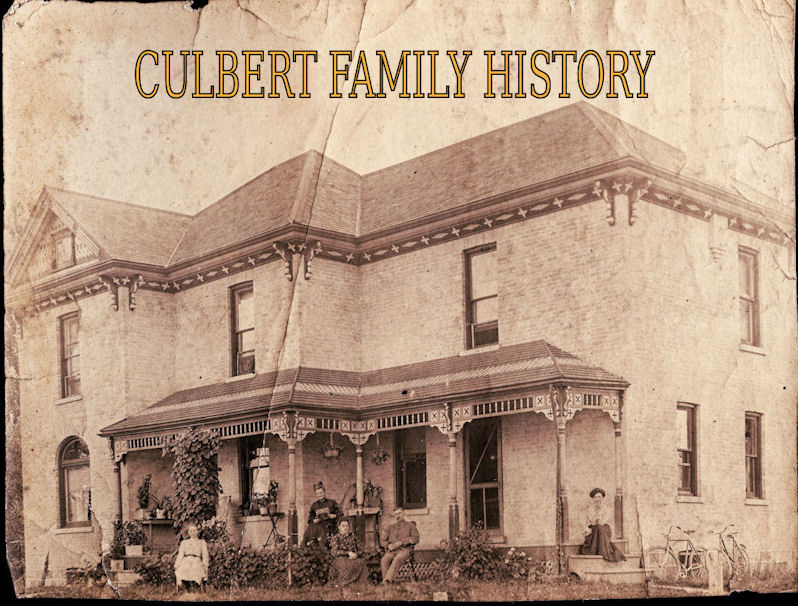Culbert Family History presents a memoir of Mel Culbert (1920-1958) lovingly written by his son, Terrence Patrick "Terry" Culbert.
 |
| Mel Culbert holding his son, Terry, with wife, Mary Elizabeth (Patrick) Culbert |
MILWARD TAYLOR CULBERT (My father / me Da) by
Terrence Patrick Culbert
I lost the
greatest male influence of my life when I was only sixteen years of age. That
person was my father Milward Taylor Culbert, known affectionately by friends
and relatives as Mel or in my case, Dad! Dad was one of six sons born to my
grandparents Myron and Effie Culbert on their 100-acre farm just north of
Lucan, Ontario. Poplar Farm as it was called had been in the Culbert name since
1840 when John and Mary Culbert immigrated to Upper Canada from Tipperary,
Ireland.
 |
| Milward Taylor "Mel" Culbert. Born 29 May 1920 on the Culbert homestead near Lucan, Ontario to parents Myron Manford Culbert & Effie Pearl (Taylor) Culbert. |
I was born in
1942 during the Second World War. My father was a radar technician in the RCAF
(Royal Canadian Air Force) and because of a severe case of nose bleeds, dad was
grounded. He was retrained as a draftsman and transferred from Trenton to a
base on Avenue Road in Toronto.
 |
| Mel Culbert and his son, Terry |
After the
war, dad, mom and I moved to the south-western Ontario city of London where dad
took up his old job as a clerk in a dry goods store on Dundas Street. At this
point my sister Dana Elizabeth was born.
Still in his
twenties, dad became restless; he obviously required more stimulation in his
career. He became a travelling salesman for Irwin Toys out of Toronto with
London and the Bruce Peninsula being territory.
The longing
to be his own boss never left him and he began the next stage of his life,
opening a very successful business in the Village of Lucan, sixteen miles north
of London.
 |
| Mel Culbert's Dry Goods Store on Main Street, Lucan was in this building during the 1950s. In more recent times, the building housed this art gallery and florist's shop. Mel and his family lived above the right hand side of the store. |
Dad’s store
was similar to a country general store or a small department store with a men’s,
women’s and children’s sections. He sold clothing, cosmetics, toys, candies,
yard goods and rubber boots. He also employed two village women full-time: Mrs.
McFalls and Mrs. Young.
I was taught
by dad how to keep the store neat and tidy, how to put price tags on the
various items and how to be polite while waiting on customers. For these new
skills, I received an allowance.
Dad was
extremely hard working, sometimes very strict with sister Dana and me, but
always loving. With his tall, slim physique, blue eyes, sporting a neatly
trimmed moustache with blonde curly hair, dad was adored by many of the village
women. One such woman, the mother of my best friend, would enter the store
carrying a loaf of freshly baked bread for him and he would burst out in song
each time with: “June is busting out all over.” Rubenesque June would smile
from ear to ear.
Dad was a
member of the Lions Club, the Masons and a Boy Scout leader. He and my mother
were at loggerheads as to which denomination I should be christened. Dad
finally won and at the age of twelve, I was baptised along with a couple new-borns
in the United Church. Very embarrassing moment in my life.
Dad was a
huge supporter of my artistic skills and was instrumental in getting me into
art school in London, Ontario. In the apartment above our store, I would wake
up in the middle of the night with an idea for a school project and have to put
it on paper right then and there. Dad seeing the light shining from beneath my
bedroom door would enter with a smile, suggesting I get some sleep.
Drawing and
painting all my life, interrupted only to work in the world of television news
for 42-years, art became a reality for me. At the age of sixty I retired and
began painting full-time with my fabulous partner Barb Hogenauer; sharing
studio space together on Amherst Island, Ontario for ten years and as of March
15, 2018, five years in Prince Edward County, Ontario. Thank you dad, for
believing in me.
 |
| Mel Culbert and his son, Terry |
My dad was
very ill for many years. I never knew him to complain. He died in 1958 at the
young age of thirty-eight. He never really got to know his youngest daughter,
my kid sister Mary Jane as she was just a year old. Mom and dad were building
their dream home at the time of his death. He never saw it finished. Sixty
years later, I still miss him.


































